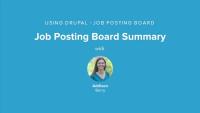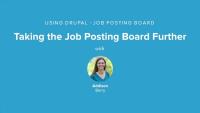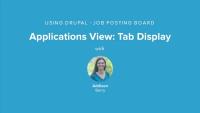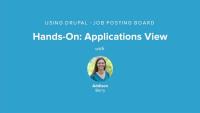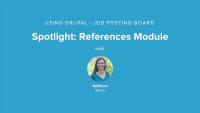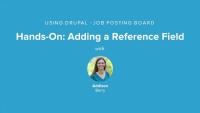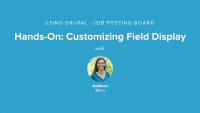With so much data in so many places on the web, more and more site builders find that they need to get external data into their Drupal sites. It's a common problem with many ways to solve. One of the best ways to tackle this in Drupal is to use the Migrate module. The new Importing Data With Migrate and Drupal 7 series will teach you how to use the Migrate module to take data that exists in different source locations and import that into a Drupal 7 website.
This series taught you how to use two of Drupal’s fundamental “building block” modules: Field and Views. These modules constitute the cornerstone of Drupal’s power and are used extensively throughout the rest of the Using Drupal series. In this summary we'll take a tour the Epic University site we've built to discuss how we built it. We'll wrap things up with a review of the modules and resources we've covered in this series.
Additional resources
The basic job website that we’ve built only touches on the surface of the capability of Field and Views. There are a lot of possibilities for extending the functionality of this job site by adding more fields to both the Job and Job Application content types. In this lesson we'll review some other modules to explore:
- Automatic Node Titles
- Node Reference URL Widget
- Content Access
- Field Permissions
Additional resources
Today we are going to wrap things up on the Using Drupal Chapter 3: Job Board series. We've created a site that meets the Epic University requirements, and learned the fundamental building blocks of putting together a Drupal site. In our last two lessons we are going to look at modules we could use to make our site even better, and then we are going to do our final tour and review of the site we've built, looking at what we've done, and how we built it.
In Episode 25 of the Drupalize.Me Podcast, Kyle Hofmeyer takes time to gather some Lullabots to discuss "developer workflow".
With our basic Applications view built, we have our default display. We also need another faculty display on the site. This second list will be largely the same as the default list, but it needs to show up as a tab on a job posting node, and only list the applications which relate to that particular job. We're going to need to create a new display, and override certain settings, plus add in a contextual filter, in order to get this view completed.
Additional resources
In this lesson we tackle the last display we need for our Applications view, by building a block for our applicants. This has us creating a new type of display, a block, as well as continuing to work with overrides. We also have to change the permissions on this particular display so regular users can see it, but at the same time we only want the view to show a user their own applications.
Additional resources
The Applications view will serve both as a tool for administrators and as a reference for users, with three different displays. In this lesson, we'll start to build the Applications view by creating the default display with our first listing, which is a master list of all the applications on the site. To pull in all of the information we're going to need, we'll begin working with Views relationships.
Additional resources
We are getting close to completing our site in the Using Drupal Chapter 3: Job Board series. This week we are going to finish up our requirements by building out the Applications view. This view gets a little tricky though, because we need to create three very different displays, and control who has access to some of those displays. This means we'll be doing a lot of overrides in our different displays. We also get to work with Views relationships to pull even more information into our view.
You've probably heard of this magical land of version control where you can undo bad things, start over, and share your work effortlessly. It's a wonderful place that, let's face it, actually takes a bit of work to get to. It's a lot like Drupal: the more time you spend with version control, the more you forget how hard and complicated it was at the very beginning. And even when you understand it, you can still get yourself into a fuddle sometimes.
Supporting Open Source the Gittip Way
Blog postThere has been a lot of talk in the Drupal community recently about Gittip. Gittip is a way to donate money to people who are doing good work. The part that really makes Gittip different from other donation or crowd-funding plans is that it is set up to provide regular, weekly payments. One-time gifts are great, but a steady source of income is what a lot of people really need, especially folks who are mostly unemployed and working essentially for free on projects you care about. A few weeks back we had Alex Pott on the podcast (Episode 23: Alex Pott and Working on Drupal Core) to talk about his work, and the fact that he has been self-funding himself to be able to focus on Drupal core. We think this is a really, really important conversation in the Drupal community, and definitely recommend you listen to the podcast for more insight.
The Views module provides listings of data on your site: users, comments, nodes, and more. Any listing of data provided by the Views module is called a view, and most Drupal websites today use Views in many different ways. In this lesson we'll get an overview of the Views module, including some specific concepts and terminology like Data Types and Displays, along with a tour of the major view settings and what they do.
Additional resources
The requirements of our site include two different main views. One view is a public-facing list, showing all the available jobs to users of the site. In this lesson we'll create our first view by enabling the modules we need, walking through the Views wizard to get our basic view in place, and then modifying various settings for our fields and working with contextual filters.
Additional resources
Release Day: Using the Views Module
Blog postIn this week's installment of the Using Drupal Chapter 3: Job Board series, we get into the world of Views. The Views module is the most used contributed module in Drupal 7. It is so popular in fact, that it has been included in core for Drupal 8. Views lets us list content on our site. It can be used to accomplish so many tasks when it comes to building your site that you really do need a good foundation with this to understand many Drupal site-building concepts.
Podcast Episode 24: Coderdojo and Drupal
Blog post In Episode 24 of the Drupalize.Me podcast, Addi is joined by Bill Liao, co-founder of CoderDojo, and Drupalers and CoderDojo volunteers Heather James (heather) and Mike King (emkay).
In Episode 24 of the Drupalize.Me podcast, Addi is joined by Bill Liao, co-founder of CoderDojo, and Drupalers and CoderDojo volunteers Heather James (heather) and Mike King (emkay).
Now that the university is able to create job postings, it would be helpful if prospective employees could submit resumés to the positions in which they’re interested. In this lesson we will build out the Job Application content type. We will need to add another reference field, this time a node reference, to tie the applications to the correct job. To make it possible for applicants to submit their resumé we'll also need to add an upload field so that applicants can upload a document of specified file types.
Additional resources
The References module is a contributed module that allows you to create relationships between nodes and/or users. In this lesson we will take a look at the References project, explaining how References work, and then discuss some similar modules out there you may want to investigate.
Additional resources
Now we need to add a primary contact for the job position we've created. This will usually be the person creating the entry, but we’ll allow the user to enter any of the possible faculty members on the site. This will be done as a “User reference” field, provided by the contributed References module.
Additional resources
For usability, it’s often important to display forms and page contents in a specific order, and to add formatting so that it’s more clear what data is being presented. In this lesson we'll modify our Job content by reordering the fields, changing the field label display, and looking at how we can hide particular fields.
